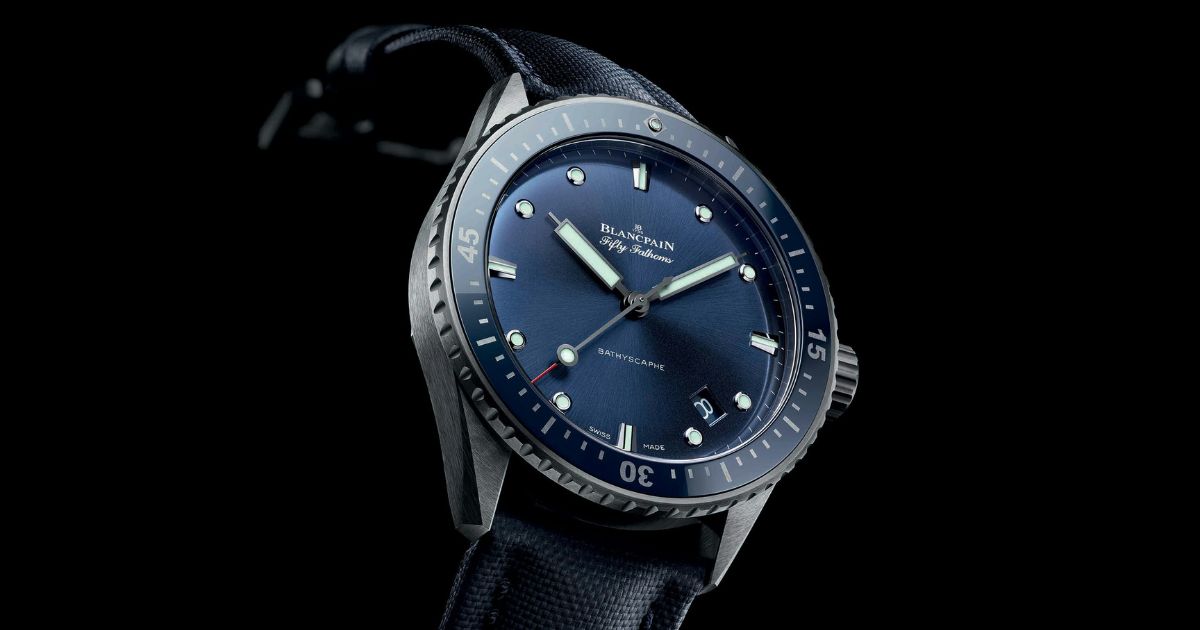Our Magazine
The Fifty Fathoms: How a Legend Was Born

If you were to close your eyes and picture the quintessential dive watch, what comes to mind? A robust case, a starkly legible dial, a unidirectional bezel, and an aura of undeniable tool-watch purpose. While many timepieces check these boxes today, there is one that not only defined the template but did so out of sheer, unadulterated necessity. This is the story of the Blancpain Fifty Fathoms—a legend forged in the depths of post-war France, born from the vision of two passionate men and the relentless demands of combat divers.
Welcome, fellow horology enthusiasts, to a deep dive into one of the most important tool watches ever created. Understanding the Fifty Fathoms is essential for any serious student of watchmaking, as it is a masterpiece of form following function, a narrative where history and mechanics are inextricably intertwined.
The Protagonist: Captain Robert "Bob" Maloubier
Our story begins not in a Swiss manufacture, but in the shadowy world of post-World War II French naval warfare. Captain Robert “Bob” Maloubier, a decorated hero of the French Resistance and a founding member of the French combat diving corps, the nageurs de combat, was tasked with equipping this new elite unit. He and his fellow officer, Lieutenant Claude Riffaud, faced a critical problem: there was no reliable underwater timepiece available.
The watches they tested were disastrous. They fogged up, leaked, had unreadable dials, and featured bezels that could be easily knocked out of position, posing a lethal danger to a diver calculating their remaining air supply. Maloubier, a man of action, didn’t just complain; he drafted a precise set of specifications for his ideal dive watch. It needed to be waterproof, legible in the murkiest conditions, and equipped with a lockable, unidirectional bezel to prevent accidental extension of dive time.
The Patron: Jean-Jacques Fiechter
Armed with his specifications, Maloubier embarked on a quest to find a watchmaker capable of bringing his vision to life. Rejected by the larger, more famous brands of the time, he eventually knocked on the door of a small, prestigious firm in the Vallée de Joux: Blancpain. And here, our second protagonist enters: Jean-Jacques Fiechter, the CEO of Blancpain and a passionate diver himself.
Fiechter was not just a businessman; he was an innovator and a user. He had been independently working on his own dive watch prototypes, facing the same challenges Maloubier described. The convergence of their needs was serendipitous. Fiechter’s personal obsession with the underwater world made him the perfect architect for the captain’s blueprint. Together, they refined the concept, and in 1953, the Blancpain Fifty Fathoms was born. The name itself is a unit of measurement: fifty fathoms equal approximately 91 meters, which was considered the maximum operating depth for the diving equipment of the era.
The Blueprint of a Legend: The Defining Features
The original Fifty Fathoms wasn’t just a watch; it was a system. Every single feature was a direct response to a diver’s need. Let’s break down these pioneering elements:
-
The Unidirectional Rotating Bezel: This is arguably the Fifty Fathoms’ most significant contribution to horology. Fiechter and Maloubier understood that a diver must be able to track elapsed time, and that an accidental counter-clockwise turn could falsely indicate moreremaining air, leading to a fatal case of decompression sickness. The solution was a bezel that only rotated counter-clockwise. If it was bumped, it would only shorten the perceived dive time, ensuring a safety margin. The early “blancpain” engraved bezels also featured a locking mechanism to prevent any movement whatsoever.
-
Super-LumiNova (Before It Was Cool): Legibility was paramount. The Fifty Fathoms featured large, bold Arabic numerals at the cardinal points. The hands were broad and sword-shaped, and the hour markers were painted with a then-revolutionary radioactive material: radium. While we now know the dangers of radium, at the time, it was the only way to achieve the intense, long-lasting luminosity needed for zero-visibility dives. The high-contrast black dial and light-colored markers created a “negative display” effect that was exceptionally easy to read.
-
The Double O-Ring Crown: Water resistance was non-negotiable. Fiechter pioneered the use of two O-ring gaskets on the crown, creating a double-sealed system that was far more resistant to the ingress of water than any single-gasket design. This was a fundamental engineering breakthrough that became an industry standard.
-
Automatic Movement: In a brilliant stroke of practicality, the Fifty Fathoms was equipped with an automatic (self-winding) movement. The reasoning was simple: a combat diver operating in harsh conditions should not have to worry about manually winding his watch, which could compromise the water resistance with daily manipulation of the crown.
Conquest of the Seas: From France to the World
The French Navy’s adoption of the Fifty Fathoms was its first major endorsement. But the legend was about to go global. In the United States, the watch caught the attention of a certain Lieutenant Colonel, and soon after, the U.S. Navy’s elite counter-measures and minesweeping unit, the UDT (Underwater Demolition Teams, the precursors to the Navy SEALs), adopted it. The German Bundesmarine followed suit.
Perhaps its most famous military association was with the French combat diving corps, which required a special “No Radiations” model. Fearing the radium could give away a diver’s position, these watches featured a simple, sterile dial without the radium symbols, marked only with “Fifty Fathoms Automatic.” These rare pieces are now among the most coveted by collectors.
A Living Legacy
The story of the Fifty Fathoms is not a relic of the past. It is a living, breathing legacy. While the technology has evolved—replacing radium with safer lume, introducing antimagnetic silicon balance springs, and pushing depth ratings far beyond the original fifty fathoms—the core design language and philosophical principles remain untouched.
When you hold a modern Fifty Fathoms, you are not just holding a luxury sports watch. You are holding a piece of history. You are holding the tangible result of a dialogue between a warrior who needed a tool and a craftsman who knew how to build it. It is a watch born from function, whose form became an icon.
For the watch enthusiast, the Fifty Fathoms serves as a perfect case study. It reminds us that the greatest designs are often born from the most rigorous constraints. It teaches us that true luxury, in a horological sense, is not about ornamentation, but about impeccable engineering, purpose-driven design, and a story that is as deep and compelling as the oceans it was built to explore. The Fifty Fathoms wasn’t just made; it was born, and its legend continues to tick, second by deliberate second.













